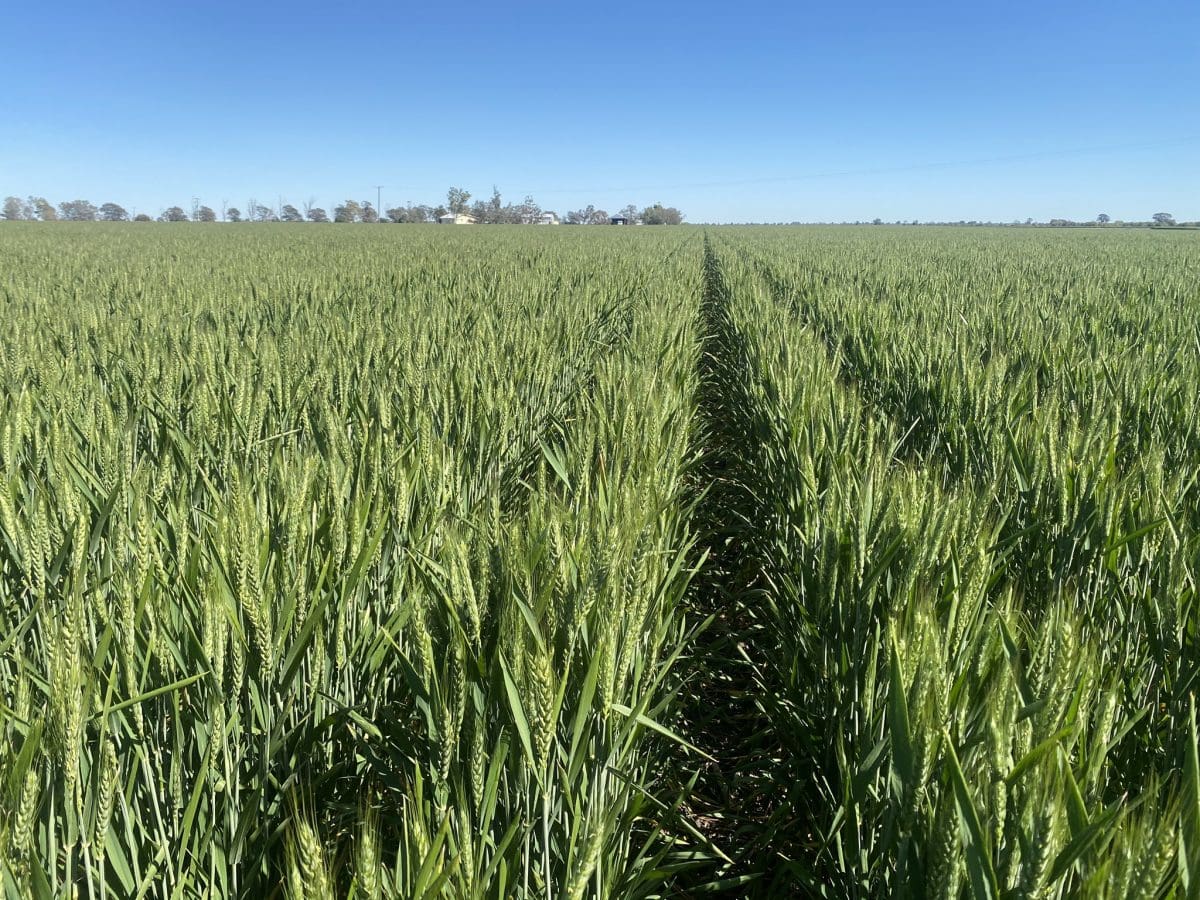
This crop of RockStar wheat at Croppa Creek escaped damage from last week’s patchy frosts. Photo: Katherine Munn, Intergrain
NORTHERN barley prices firmed in the past week as the market juggled nearby and forecast feed demand with limited supply, while the start of the Queensland wheat harvest saw old and new-crop markets converge.
In southern markets, nearby barley firmed a little as consumers covered the last of their positions before the arrival of new-crop, and new-crop wheat and barley values firmed as traders accumulated grain for exports from January onward.
On sorghum, the first and possibly only cargo of new crop from the 2020 harvest is booked to load at Gladstone in Central Queensland later this month, which is helping to support nearby values.
| This week | Last week | Change | |
| Barley Downs Sep | $300 | $280-$295 | Up |
| Barley Downs Jan | $240 | $238 | Up |
| Barley Melbourne Sep | $235 | $230 | Up |
| Barley Melbourne Jan | $230 | $230 | Steady |
| Wheat Downs Sep | $295 | $340-$345 | Down |
| Wheat Downs Jan | $290 | $282 | Up |
| Wheat Melbourne Sep | $305 | $305 | Steady |
| Wheat Melbourne Jan | $285 | $282 | Up |
| Sorghum Downs Sep | $318 | $315 | Up |
| Sorghum Downs Mar-Apr | $290 | $280 | Up |
Table 1: Indicative delivered grain prices in AUD per tonne.
Switch-over in north
The trucking of barley from Victoria to the southern Queensland’s western Darling Downs region is expected to wind up next week as feedlots start to switch supply to local new crop.
The dying days of this market are returning growers around $200/tonne on farm in northern Victoria.
In Central Queensland and pockets of the western Downs, early crops of wheat as well as barley are being harvested, but volumes will be limited for another fortnight or so.
Some localised frost damage is being seen in pockets of the crop from South Australia through to southern Queensland, and has tempered grower interest in forward selling.
This is helping to support prices.
“Markets seem to be $4-$5/t firmer this week for wheat and barley, even though there’s a bit coming off around Meandarra,” one trader said.
Sources said feedlots were juggling softening grid prices from meat processors, heady restocker demand and grain prices which appear to be finding support at export parity, and reducing their numbers on feed as a result.
“You’d expect processors will be looking for good grassfed cattle well into next year if these pasture conditions stay like they are.”
In New South Wales from Narrabri southward, crop conditions are looking excellent and yields of 4-5t per hectare or more look achievable across the board.
In southern NSW, barley is trading on farm at $190-$200/t for current crop and $10/t less for new crop. Supporting the prompt market, consumers are chasing their last load or two for nearby.
Wet harvest possible
Growers of wheat in all districts are advancing their forward sales on multi-grade contracts, with base-grade Australian Premium White (APW1) wheat at around $240-$250/t delivered local depot.
“With a fixed spread, that locks in prices on the bottom side, and if growers can get $190-$200/t for shot-and-sprung wheat when APW was $260-$270/t, that’s not bad.”
Concerns about a wet harvest fuelled by the Bureau of Meteorology’s forecast for a La Nina have growers careful not to over-commit on high-quality milling wheat.
In northern NSW, Stewarts Grain Trading trader Robert Quinn said growers had been reasonably active on forward selling in the past two or three weeks, but selling had slowed in the wake of frosts last week.
This has sparked minor concerns about impacts on grain yield and quality.
“We had three or four frosts and they were reasonably widespread.”
The prompt market for barley delivered to northern NSW feedlots is around $275/t, around $55/t above new crop but the new crop will not be available in considerable volume until November.
Small amounts of barley ex the dwindling Brisbane free-on-truck market were offered at around $300/t, with tonnage mostly going to coastal and Brisbane Valley consumers.
“Not a lot of consumers are on wheat, and the local consumer is pretty much covered up to harvest delivery.”
The northern NSW barley harvest is expected to start next month.
Mr Quinn estimates most growers in the Moree district would be maximum 20-per-cent forward sold on new-crop cereals.
“We’re only going to have average crops around Moree because we missed out on those bigger falls of rain they were getting a bit further south.”
SA conditions improved
In South Australia, Australian Grain Exports trader Tyson Hewett said growers advanced their forward sales programs after much-needed rain fell last month to underpin production prospects for wheat and barley.
“We had a dry June and July, so the crop won’t try and overproduce.
“Hopefully that means we won’t have screenings issue.”
Mr Hewett said crops could do with a further 20-50 millimetres of rain to bolster the yield outlook.
Last month’s rain, and the knowledge that the SA harvest should be under way in earliest areas next month, have removed the inverse between current and new-crop barley.
“It was $30-$40/t a few weeks ago; it’s just about gone now.”
Wheat’s premium to barley of around $75/t is unusually large, and based on the state’s low stocks of wheat heading into new-crop.
In its monthly stocks report released on Tuesday, Viterra as SA’s biggest bulk handler said its wheat stocks stood at 151,295t, with barley at 202,333t, both historically low numbers.
Grain Central: Get our free daily cropping news straight to your inbox – Click here

HAVE YOUR SAY